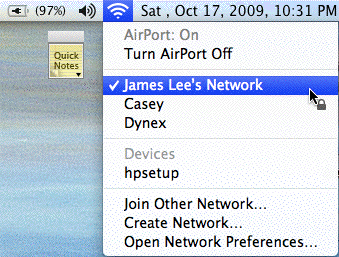UI COMMENTS
In Mac User Interface parlance, a System Menu is any menu on the main menu bar. The AirPort status menu shown below (to the right of the TopXNotes QuickNotes floating window) is an example.

There are several alternatives to the System Menu to provide instant access from the desktop to a list. The one we will examine is the combination of a global floating window with dropdown menu I designed for the application TopXNotes. It is shown below with its list of “QuickNotes” (selected by the user) extended.

A System Menu, has, by virtue of being a menu in a fixed menu bar, Consistent User Interface, or CUI. That is on goes back to that same spot on the screen always for the same item. TopXNotes QuickNotes feature also has CUI, since the list of notes designated QuickNotes always drop from the QuickNotes floating window, and because TopXNotes remembers its location, it will not only be consistent, it is consistent at a location chosen by the user.
USAGE
In both the System Menu and in TopXNotes, usage is the same, “instant desktop access”. For the Mac OS System Menus, they save several steps over opening Apple’s Mac OS X System Preferences and navigating to the Preference to adjust. For TopXNotes, the QuickNotes menu provides instant desktop access to our customer’s most important information. One thing it does not provide is getting lost in the clutter of System Menus with all the Apple and other System Menus in the main Mac menu bar. Our customers really like this feature and MacWorld’s four mouse review called it our “killer feature”
For more details on QuickNotes, visit TopXNotes.